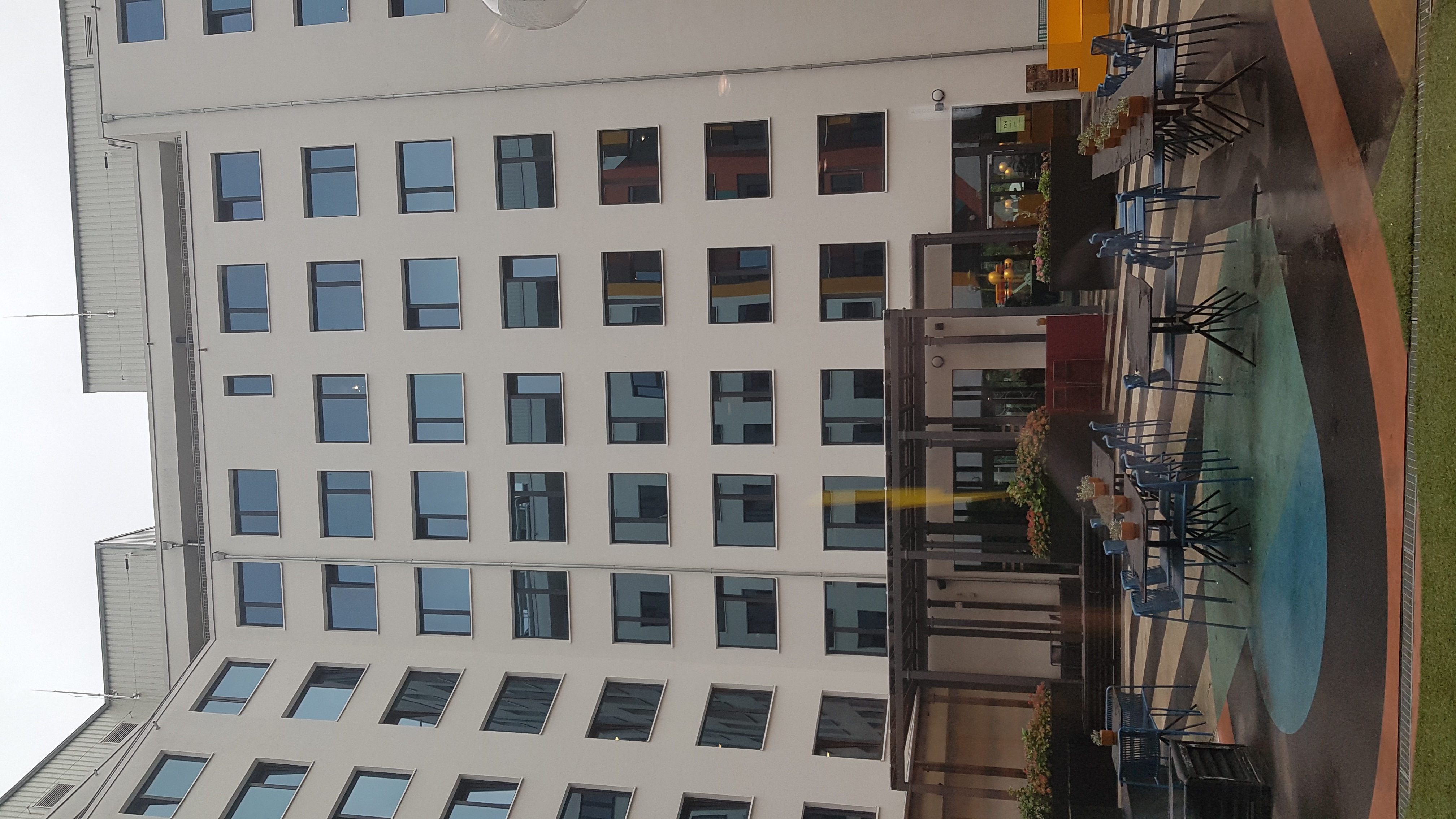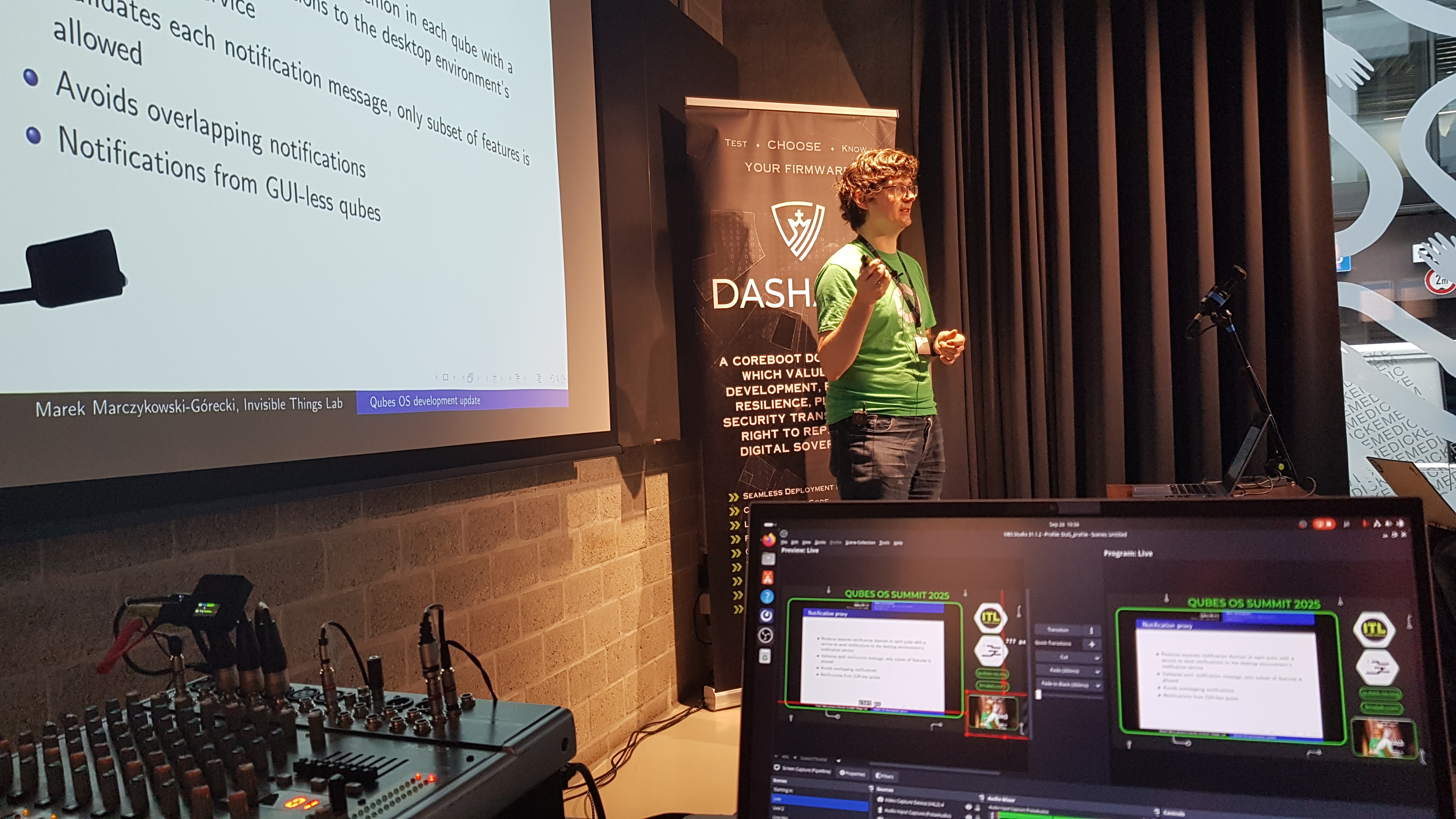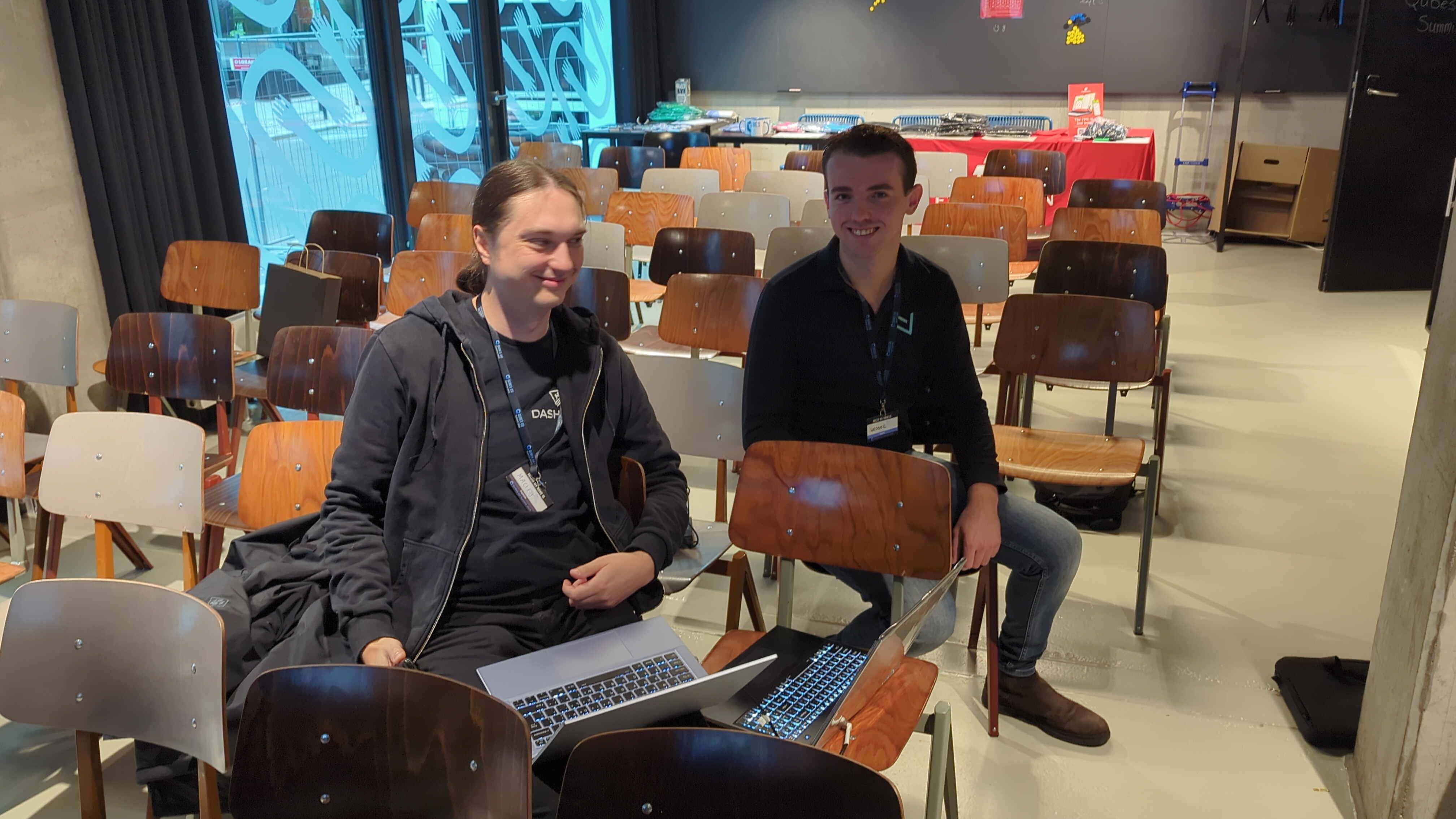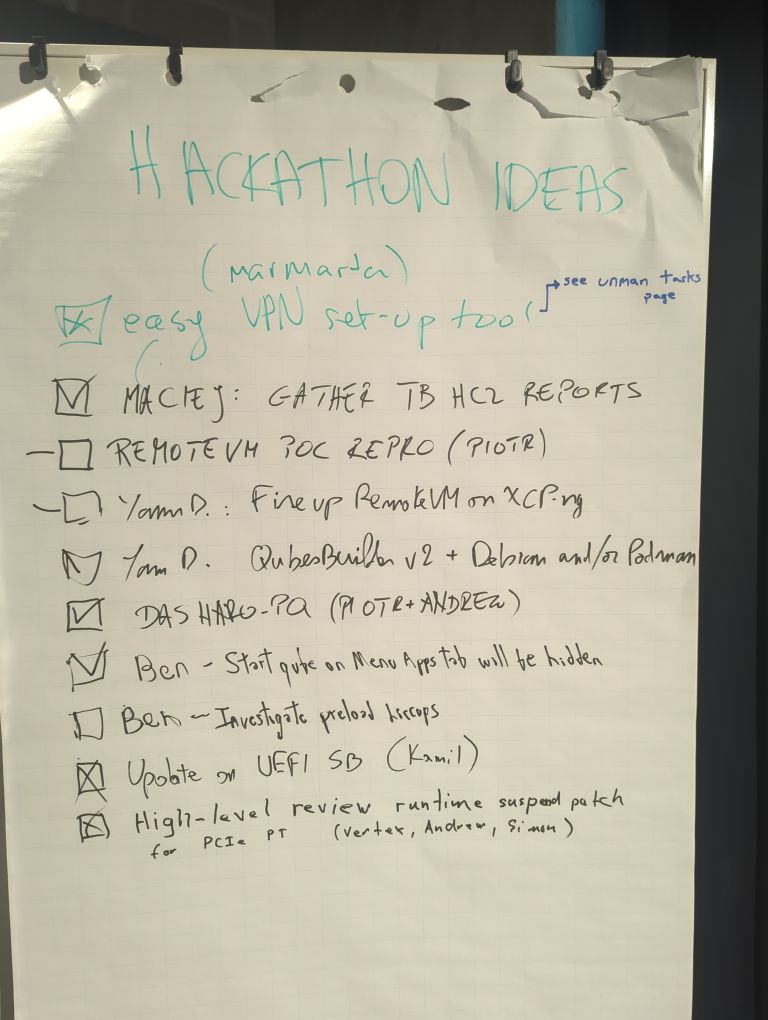Introduction
Qubes OS Summit 2025 happened September 26-28 in Berlin at The Social Hub. Three days of talks, discussions, and hackathon work. The event wouldn’t exist without sponsors - Freedom of the Press Foundation and ExpressVPN (Platinum Partners), Mullvad VPN (Gold Partner), and NovaCustom, Nitrokey, and PowerUp Privacy (Silver Partners). Their support made it possible to host the community and livestream talks for remote participants.

Behind the scenes, there’s a lot of work that happens throughout the year: negotiating venue, coordinating accommodations, planning the afterparty at BRLO Beer Garden, and managing logistics. Special recognition to the audio-video team - Rafał Kochanowski from 3mdeb and Stanisław Bieniek - who kept streaming and recording running smoothly both days. And to Magda Kochanowska, who handled attendee onboarding and kept things organized on-site. Invisible Things Lab and 3mdeb co-organized, continuing the Summit tradition since 2019.
The conference covered Qubes OS R4.3 updates (Marek Marczykowski-Górecki), GUI/UX improvements (Marta “marmarta” Marczykowska-Górecka), infrastructure advances, and contributions from the Dasharo ecosystem. Michał Żygowski presented on server hardware/firmware foundations for Qubes Air, Kamil Aronowski on UEFI Secure Boot progress, Maciej Pijanowski on TrenchBoot hardware compatibility, and I presented on RemoteVM architecture for Qubes Air. NovaCustom’s Wessel klein Snakenborg - a customer and supporter whose investment brings capital for ecosystem growth - discussed firmware updates including Dasharo features. Rafał Wojdyła from ITL covered Windows Tools improvements. Also: Alyssa Ross on Spectrum OS, corporate deployment (Matthias Ferdinand), EU CRA implications (Peter Schoo), and infrastructure sessions on Ansible, device management, and disposable VM performance.
Hackathon on day three: TrenchBoot HCL testing, Dasharo Patchqueue Initiative, UEFI Secure Boot work, QubesBuilder v2 improvements, and other projects. Talk recordings and details: conference schedule.
Day 1 Highlights (September 26)

Qubes OS 4.3 Development Update
Marek Marczykowski-Górecki opened with an overview of what’s coming in Qubes OS 4.3. Many features mentioned in this presentation got separate dedicated presentations later in the summit. The update covered improvements across the board - disposable VM preloading for better performance, Ansible integration for automation, and various GUI improvements that we’d hear more about from Marta.
GUI and UX: Design for Hackers
Marta “marmarta” Marczykowska-Górecka’s talk focused on how to contribute to GUI tools without being intimidated by the process. Contributing to GUI tools can be daunting - it’s not easy to test things on Qubes OS, the whole OS stack is enormous, and the idea of designing an interface is quite scary to many developers. But it doesn’t have to be that bad.
The talk started with the observation that not everyone reads manuals and complete release notes. CLI has a high barrier to entry. GUI development doesn’t require you to be an artist, and you don’t have to extensively communicate with others if you’re not comfortable with that. But you do need to understand design fundamentals.
Marta emphasized the “happy path” concept - the typical, positive user journey where good UX causes problems to get out of your way. Many developers have false assumption bias about other people’s skills and knowledge, and how programs and interfaces should be used. Information architecture is crucial: simple options first, rarely-used features should be hidden or in advanced options. The expert bias problem is that experts think everything is important and struggle to decide what’s more critical or what isn’t - they want to explain everything.
Don’t overload the interface. Most often we’re not building interfaces for ourselves - code is read more often than it’s written. We’re very bad at assessing other people’s skills, assuming significant knowledge on the listener’s part without accounting for our own competencies. Personas are important. We think 80% of people are like us, but the opposite is true - most people are not like us. Personas should help answer whether this mechanism or interface will work for that user. Users adapt to developers, and developers to users - sometimes.
Attention span matters. Developers remember more details naturally, but users can be distracted at any moment. Always remind them what each option is for and why. Global Config is a good example where each option has smaller text explaining what, how, and why. When deleting a qube, confirmation requires typing the name - things happen accidentally, so we shouldn’t give “Yes/No” or “Accept/Cancel” confirmation windows because those get ignored.
Consistency is important. Default or most-used action buttons go on the left side, colored blue. Alignment and symmetry provide better UX. Things that are related should be close together, distant things aren’t related - grouping matters. PenPot is probably the best FOSS tool for interface sketches. There’s a component library for Qubes. Lucide.dev is a good tool for icons - creating icons is very difficult.
Corporate Deployment: Have Your Qubes and Keep It?
Matthias Ferdinand presented on using Qubes OS as admin workstations in their corporate IT environment. This was one of the best talks at the summit. Using Qubes requires some changes on both sides - adapting corporate processes for Qubes and adapting Qubes usage for corporate requirements - while trying not to ruin security on either side. Surely there is room for improvement.
The discussion touched on practical challenges of deploying Qubes in an environment where IT infrastructure expects certain patterns and behaviors. How do you handle corporate authentication? How do you manage policy for users who need access to internal resources while maintaining Qubes' isolation model? The talk was valuable because it came from real-world experience, not theoretical deployment scenarios.
Spectrum OS: Rethinking Compartmentalization
Alyssa Ross is the founder and project lead of Spectrum, an in-development compartmentalized operating system. It’s heavily inspired by Qubes OS, but also does a lot of things differently. The talk highlighted differences between Spectrum and Qubes OS, with particular focus on user and developer experience, explaining the reasoning behind those differences and what Qubes OS might be able to take from Spectrum’s experience doing things differently.
Particular areas covered included Spectrum’s immutable host system and purely functional build process, tight integration between base OS, desktop environment, and VMs, use of XDG Desktop Portals, and focus on avoiding the need for system maintenance work from users. It’s interesting to see what architectural choices someone makes when building a compartmentalized OS from scratch with the benefit of hindsight from Qubes' development.
Alternative Qube Ownership Visualization
Ali Mirjamali (presenting online) shared his personal quest of implementing alternative approaches to the default 8 label colors. The work includes tools to create and manage additional label colors (and why it matters), alternate icons for the App Menu, alternative effects to the default tint (overlay, thin/thick borders/untouched/invert/compositor), sending windows of specific qubes to designated workspaces, and alternate border styles (solid/dash/dot/…). Talk details and video
The Future of Qube Manager: Design Session
Marta and Christopher Hunter from Ura Design led a design session on the future of Qube Manager. The history of Qube(s) Manager is long and fraught - for a brief time it was even completely removed, until popular outcry summoned it back. This session discussed with the community possible futures and ideas for how a Qubes OS installation should be managed.
Using Segregation to Hyper-Secure Development Environments
Rene Malmgren discussed what we can learn from threats like SolarWinds and Bybit/Safe, as well as high-end vulnerabilities like libXv and regreSSHion. After four years at Ericsson and now one year in the crypto industry, he presented how segregated operating systems like Qubes can be deployed to protect important assets such as cryptographic keys - making them resistant to even the most advanced actors.
Dasharo Ecosystem Impact
Server Hardware and Firmware Foundations for Qubes Air
Michał Żygowski presented on Qubes Air: Hardware, Firmware, and Architectural Foundations. The talk’s goal was to start discussion about Qubes Air and Qubes OS Hardware Certification for server-class hardware - something that will be inevitable in the Qubes Air world where compute resources are distributed across multiple physical systems.
Modern server platforms offer significant advantages over desktop hardware: expanded PCIe capabilities, non-standard high-performance connectors like MCIO, massive RAM capacity, and Baseboard Management Controllers (BMC). These bleeding-edge features are exactly what Qubes Air will need for distributed compartmentalization at scale.
Two concrete platforms are progressing toward Qubes OS Hardware Certification. ASRock Rack’s SPC741D8 already ships with Dasharo firmware support. The Gigabyte MZ33-AR1 with AMD Turin EPYC processors is targeted for Q4 2025 - ongoing porting work documented in blog posts covers PCIe initialization, AMD PSP blob analysis, and USB/SATA port mapping. This platform represents the newest generation of AMD server processors with OpenSIL support.
Security improvements for server platforms include ZarhusBMC - an open-source BMC replacement planned to replace proprietary solutions, enabling verifiable security properties. Platform Firmware Resiliency (PFR) provides additional protection against firmware attacks. AMD’s Secure Encrypted Virtualization (SEV) features offer auditable code for memory encryption, which could significantly improve security for Qubes Air’s distributed VM model.
Why does open-source firmware porting and Qubes OS Hardware Certification matter from a firmware perspective? This is the foundation for trustworthy server platforms. Without certified, auditable firmware stacks, Qubes Air’s security model breaks down - you can’t compartmentalize trust if the underlying platform firmware is opaque.
NovaCustom Firmware Updates

On Day 2, Wessel klein Snakenborg from NovaCustom presented updates on Intel Boot Guard fusing, HSI levels, Capsule Updates and new products. We started presentations on time with Wessel, who presented information on products and functionality introduced over the last year:
- NUC Box initial release
- Dasharo TrustRoot
- HSI level 3
- UEFI Capsule update
- Dasharo ACPI in kernel v6.16
- A lot of bug fixes
Plans include AMD somewhere in 2026. Servers and tablets are in plans. Dasharo TrustRoot was presented and explained. The ACPI Dasharo driver delivers quite a lot of quality-of-life functions, more than typical developers assume: fan speed, temperature, backlight control feedback, profiles, power management, etc.
UEFI Capsule Update for Dasharo and EC firmware which both can be flashed from coreboot before locks are applied. Upcoming DTS will switch to Capsule Updates and with that support we should also see LVFS/fwupd support. A discount code was offered for NovaCustom products to all participants.
Dasharo TrustRoot is a feature requested by Marek and Demi during Qubes OS Summit 2024, so we can claim “delivered”. The difference from initial request is that firmware is signed not by firmware developers, but by NovaCustom.
Regarding all delays on firmware features roadmap we just wanted to admit that most is on 3mdeb, so apologies for that.
It is important to highlight role that NovaCustom’s support play in ecosystem. Thank you for bringing resources that enables continued ecosystem growth.
Qubes Air: Value Proposition and RemoteVM PoC
I presented Qubes Air: Opinionated Value Proposition for Security-Conscious Technical Professionals (video, slides). Building on Michał’s hardware foundations talk, this session outlined an opinionated vision for Qubes Air vertical integration targeting security-conscious technical professionals: security researchers, developers, privacy advocates, and SMEs in the surrounding ecosystem.
The presentation was grounded in threat model work funded by PowerUp Privacy and reviewed by Whonix/Kicksecure maintainers. The threat model defines three key actors: Experts (maintainers of security-related software, incident response teams), Adversaries (internal or external), and Auditors (governments, certification organizations, insurers). For systems where trustworthiness is a requirement not an option, controlling the Root of Trust and Chain of Trust becomes critical.
The talk explored vertical integration of secure thin clients and robust servers equipped with Dasharo firmware and Qubes OS. Key focus areas included leveraging qrexec-based RemoteVM capabilities for secure delegation of sensitive workloads - cryptographic operations, blockchain development, malware analysis, and secure coding environments. The preliminary RemoteVM PoC demonstrates that Qubes OS R4.3 contains working service calls to RemoteVM, proving technical feasibility. Implementation strategies for attestation using TrenchBoot ecosystem were discussed for verifiable platform integrity.
The RemoteVM/qrexec demo of copying file from local VM to remote one leveraging qrexec policy checks worked impressively well in testing, though there wasn’t time to show it live during the presentation. The intentionally fast-paced delivery was designed to serve as an investor-focused pitch and reference point for future discussions with community and customers, highlighting both the practical path forward and high-value security outcomes achievable through targeted ecosystem integration.
During Q&A, xcp-ng interest emerged, leading to realization that the presented model should be adopted in other virtualization platforms. Building a trustworthy ecosystem without architecture patterns like Qubes Air would be very difficult.
UEFI Secure Boot Progress
Kamil Aronowski
gave an update on UEFI Secure Boot in Qubes
OS. He started with
introduction and explanation of UEFI Secure Boot including mention of recent
issues. UKI support didn’t land in Qubes R4.3, so we have to wait longer. Kamil
very quickly jumped into details with the hat of shim-reviewer, showing how we
check things like the .reloc section.
Some Xen issues were addressed - there is active development regarding Xen support for UEFI Secure Boot. Kamil nicely connected early communication from my presentation on Xen Winter Meetup 2025, giving a pitch about Zarhus Provisioning Box. ZPB was mentioned very shortly.
TrenchBoot: Can It Run?
Maciej Pijanowski started his talk with a very brief introduction to TrenchBoot. Then Maciej discussed hardware requirements: fTPMs vs dTPM. Microsoft distinguishes TPMs even more: iTPM and fTPM, where iTPM is an IP block in SoC and fTPM is software/firmware running in other firmware (ME/PSP).
Then Maciej explained Intel TXT support - what does it mean, how many things have to align to make it work. Maciej was essentially explaining that if you want to prove if TrenchBoot can work, there are so many factors it is unlikely to check without trying on real hardware. So you can see that offering Qubes OS AEM-enabled hardware is not that easy.
Maciej introduced meta-trenchboot based image for booting using USB, which can be used for testing. He presented test results for v0.5.2. Modern (Zen and newer) AMD are not supported. The meta-trenchboot HCL needs better marketing and inclusion in DTS, but that is not that simple, because to realize quality of DRTM implementation we have to boot platform couple times with different set of bootloader, hypervisor and kernel. 3mdeb would like to gather results as we gather HCL for Dasharo and thenks to that deliver hardware offering that can meet TrenchBoot needs. Parto of that was Maciej’s help during the hackathon to run TrenchBoot HCL to gather more results.
Day 2: Infrastructure, Automation, and Technical Deep Dives (September 27)
Qubes Windows Tools: Present and Future
Rafał Wojdyła gave an introduction to Qubes Windows Tools, which are mostly functional for Windows 10 and 11. Windows 7 support was dropped. There is a discrepancy between what windowing API is reporting and reality - there are undocumented flags used by Microsoft applications. Some windows by API status should be visible but in reality they are not, kind of a cloak mode.
There are some improvements in the Windows installer, which was rewritten in WiX4. The most important improvement is automatic approval of the test-sign driver popup. QubesBuildv2 support was another important improvement. Release signed code and performance optimizations are in the plans for future. The GUI agent is spaghetti code, so it won’t be an easy task.
Recent Advances in Device Management
Piotr Bartman-Szwarc presented the latest improvements in peripheral device handling (video) in Qubes OS, focusing on USB, block devices, and PCI. The talk explored architectural changes, security implications, and user experience enhancements introduced in recent updates.
Device identification in Qubes relies on three elements: port ID, device ID, and the backend qube to which the device is connected. This identification scheme enables proper device routing and security isolation.
A key point of confusion that Piotr clarified is the distinction between device attachment and device assignment - two different concepts with different use cases:
Attachment is for everyday device management and manual use. You attach a device when you need it right now. This approach is prone to human error (misclicks) and only works when the device is physically present in the system. It’s the typical workflow for USB drives, cameras, or other peripherals you occasionally connect.
Assignment is for automation and permanent system configuration. Assignments can be configured even when the device isn’t physically attached to the system. This makes the most sense for vault qubes where you want to permanently route specific hardware like HSM tokens or USB cryptographic devices. When the device is plugged in, it automatically goes to the correct qube without manual intervention.
Piotr presented a compatibility matrix showing which device types can be attached versus assigned, helping users understand the capabilities and limitations of each approach for different hardware categories (USB, block, PCI).
Qubes OS CI Review
Marek Marczykowski-Górecki gave a talk about CI used by Qubes OS. Frédéric contribution was custom integration to be able to leverage code from forks.
Qubes OS uses multiple runner types: docker, VM based on KVM, as well as Qubes VM (including Windows). There’s also vm-kvm - KVM with nested virtualization - which allows running Qubes in VM. This is Xen on KVM, not the other way around, but Xen works on it. Xen project works on being able to run KVM in Xen.
Arsenal for CI and validation is extensive. There are a bunch of unit tests for Python tools and linters. There is some fuzzing from Google. Build tests do reproducible tests, installing in a container, catching trivial errors.
Here we can bring paranoia level of build environment reproducibility, if what we already have is not enough. And I mean things like Guix or even StageX. By definition build environment is not part of reproducibility, but it really depends on software supply chain paranoia. In Qubes OS not everything is reproducible yet.
Other important tool is openQA, which is used for integration testing. It is essentially clicking on the screen. Other tests write commands to run Python tools. openQA has a good presentation layer for test results. End-to-end tests for split-gpg, where there is email signing and then checking if it was received and correctly signed and encrypted sound quite impressive. It helps a lot with installation. Interesting stuff is that openQA adds comments to the package updates on GitHub as test results thanks to its integration with CI.
There are compatibility tests for Qubes OS Certified Hardware, performance tests, and Windows tests, as well as some specific tests. Windows installation test was 4 hours or something like that, but that is too slow on nested virtualization.
New thing is also Orange Pi 5B based on RK3588 as the new controller added to support 4K. There is very limited testing of GPU - performance of sys-gui-gpu is low, 18fps, half of the native. There is a test for WiFi testing. Some tests and hardware platforms are participating in Xen Project CI. Automatic bisection is implemented.
Documentation and Localization
m and Tobias Killer gave a presentation about updates in documentation, its quality assurance, and the difference between Read The Docs, Sphinx, and rST:
- RTD was chosen since it has a lot of useful features, and Qubes switched to it recently. Translation was one of the most important features needed.
- Issues with Markdown admonitions were mentioned between the lines.
- Evaluation criteria defined for qualification of automatic translation were established.
- There is already Ollama running on Jetson Nano where we can call it through qubes.ConnectTCP a la Qubes Air.
All of that and more in already classical talk about so important aspect as Qubes OS documentation.
Ansible in Qubes OS
Frédéric Pierret gave a talk starting with explaining Ansible vs Salt. Ansible use is known in corporate environments. Ansible support started with kushaldas working in 2018, where an Ansible connection plugin was written from scratch. In 2024, Qubes 4.2 got Ansible 7.7 compatibility. In 2025, Qubes R4.3 got official integration - CI and packaging was added. ITL’s customers requested Ansible and it is now on its way to replace Salt in long run.
The qubes_proxy proxies Ansible execution through a management disposableVM,
sanitized with qrexec. Limitations include that access to facts and variables
from other hosts is not possible. What is good is that there are safeguards for
using incorrect strategy for execution. Bootstrapping needs installation of
packages.
Remote management is possible à la Qubes Air through mgmt VM with predefined connections like in the RemoteVM example presented in the Qubes Air PoC. It would be ideal to reproduce configuration of PoC communication.
Whole solution seem to be sound. The only regret could be years of work while integrating Salt and migration of all production quality stuff to Ansible. Hopefully Ansible will stay with us for longer.
Even More Control: Device Widget Updates
Marta’s second talk on Day 2 (Saturday) focused on practical device widget improvements. She showed the evolution of device widgets across Qubes OS versions: 4.0, 4.2, and 4.3. The most notable improvement is a way to not show child devices, which addresses the annoying problem of too many partitions cluttering the interface. For storage devices with multiple partitions, this decluttering significantly improves usability.
The talk highlighted device assignment as a valuable feature for specific use cases.
One repeating inquiry was about setting up conferencing equipment - forgetting to switch microphone and headset between qubes takes multiple iterations every time. This was why Matthias (from the corporate deployment talk) requested a dedicated conference VM.
Device assignment UI is planned for Qubes OS R4.3, making it easier to permanently configure device routing for specific workflows.
Fast and Fresh Disposable Qubes
After some technical issues related to cooperation between eDP, HDMI, and projector, Ben Grande presented on disposable VM preloading. He explained difference between named vs unnamed disposable VMs - the point is that the first do not close after closing the app, unnamed are closed. Right now time is “almost instant” and it is biggest achievement of Ben work.
Ben described couple considered approaches to solve problem of fast disposable qube. Suspend to disk deemed to be unreliable, same for Xen VM forking.
Preloading and pausing is the method building on existing Qubes infrastructure.
On startup there is waiting for the system to be fully operational, then pause
VMs. There are some options for preload: preload-dispvm-{max, threshold}.
Enabling the option preloads a number of disposables until some threshold of
free memory is crossed.
Real gain is 2x-9x. There are various situations where things can fail: insufficient memory, failure to preload, outdated volumes, interrupted qubesd. R4.3 has it enabled if >15GB of available space.
EU CRA: Seven Ways to Profit from Qubes OS
Peter Schoo gave a very important and insightful talk about details of where we are in EU CRA legislation. This presentation was not recorded and not streamed. Peter is a BSI expert contractor with a mission to inform the Qubes OS community and not only about EU CRA impact.
Questions and discussions covered several critical topics:
What is in and our of scope of EU CRA.
Training and content creation is out of scope. Any devops and automation which is delivered to clients may apply if you create and distribute tooling (Ansible, Salt). This is a gray zone a little bit - if this is a product or service, it really depends on profit, which is different from income (are you greedy?). Creation of tools and selling pre-configured machines also falls into this.
How can you give users freedom to deliver their own Root of Trust and Chain of Trust if you cannot ship that hardware? Probably transfer of ownership has to be employed. How does EU CRA see organizations which would like to help in RoT and CoT provisioning and maintenance? ISO 62304 relation and more.
December 11, 2027 is the time for setting things in stone. How should upstream and downstream vulnerabilities be handled? This radically increases the cost of products.
We appreciate the initiative and motivation to come to the QOSS event to educate us about the EU CRA.
Hackathon Results (September 28)

Day three was dedicated to hands-on hackathon work. Based on the goals whiteboard, several projects made progress:
Dasharo Patchqueue Initiative (Andrew Cooper, Piotr Król, Michał Żygowski, Maciej Pijanowski): This consumed most of my time during the hackathon. Together with Michał and Maciej, we received a lecture from Andrew Cooper on how to maintain a patch queue based on his experience from the XenServer xen.pg project. Learning from someone with that level of experience in patch queue management for Xen was incredibly valuable for our Dasharo firmware work. This took all my time, so I couldn’t work on RemoteVM PoC reproduction that I had planned.
TrenchBoot HCL Reports (Maciej): Gathering hardware compatibility reports for TrenchBoot/AEM. The meta-trenchboot USB testing image introduced during Maciej’s talk was used to collect real-world compatibility data across different hardware platforms.
UEFI Secure Boot Development (Kamil): Continued work on UEFI Secure Boot implementation, building on the progress discussed in his Day 2 talk.
QubesBuilder v2 + Debian/Podman (Yann D): Build system improvements focusing on Debian integration and Podman support for QubesBuilder version 2.
Runtime Suspend Patch Review (Vertex, Andrew, Simon): High-level review of PCIe passthrough suspend improvements - addressing one of the pain points with device management and power states.
Easy VPN Setup Tool (Marta): Quality-of-life tooling to simplify VPN configuration in Qubes, addressing a common user pain point.
The hackathon demonstrated the practical side of the summit - moving from talks and discussions to concrete implementation work and collaboration across different areas of the Qubes ecosystem.
Reflections and Observations
A note on event timing: It seems that a lot of people attended in commercial capacity on Friday. A survey was sent after the summit to gather feedback on this and other aspects, which will lead to adjustments for future events.
The summit showed maturity in several areas: comprehensive CI/testing infrastructure (Marek’s CI talk), improving documentation processes (m and Tobias), and proactive engagement with regulatory challenges like EU CRA (Peter Schoo). The Qubes Air architecture emerged as a recurring theme across multiple talks - from Michał’s server hardware foundations, to my RemoteVM presentation, to Frédéric’s Ansible remote management PoC. This suggests the community is converging on distributed computing patterns that extend Qubes beyond single workstations.
Corporate adoption challenges (Matthias Ferdinand) highlighted practical gaps that need addressing: proxy configuration as a first-class citizen, flexible IP address pool allocation, system-wide CA deployment, and better videoconferencing VM support. These aren’t just enterprise nice-to-haves - they’re requirements for broader adoption.
The Dasharo ecosystem’s role in hardware enablement continues to expand: server firmware foundations (Michał), NovaCustom customer adoption bringing capital and validation (Wessel), TrenchBoot compatibility work (Maciej), UEFI Secure Boot progress (Kamil), and the Patchqueue Initiative learning from XenServer experience (Andrew Cooper). The ecosystem needs this kind of sustained firmware and hardware certification work to make Qubes viable on modern platforms.
The comparison with Spectrum OS (Alyssa Ross) was valuable - seeing different architectural trade-offs (KVM vs Xen, image-based vs customizable, Wayland-native) helps both projects learn from each other. Competition and diversity in compartmentalized OS development is healthy for the market and drives innovation.
Overall, the summit balanced technical depth with practical deployment concerns, bringing together firmware developers, OS maintainers, corporate users, and security researchers. The afterparty at BRLO Beer Garden provided space for informal discussions that often lead to future collaborations.
We looking forward for Qubes OS Summit 2026 for which organization should start soon.
